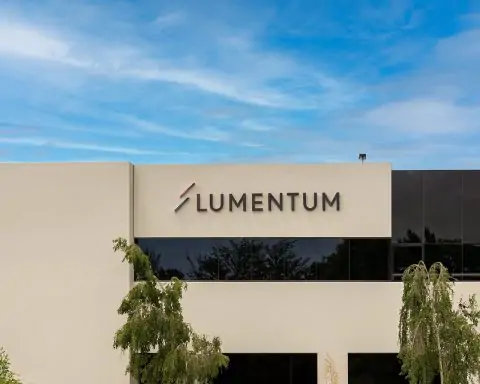- Explosive Rally: Tilray Brands (NASDAQ: TLRY) has surged roughly 300% since July 2025 amid optimism around U.S. cannabis law reform [1]. The stock recently traded around $1.70–$1.80 per share (as of Oct. 8, 2025), up from 52-week lows near $0.35 [2]. It jumped 8%+ on Oct. 7 alone after signs of bipartisan support for marijuana decriminalization [3] [4].
- Latest Catalysts: A wave of political momentum ignited the rally. Former U.S. President Donald Trump’s late-September endorsement of CBD’s health benefits for seniors – and hints at rescheduling cannabis – sent pot stocks soaring (Tilray spiked 42% on Sep. 29) [5]. This week, multiple GOP senators unexpectedly voiced support for essentially decriminalizing marijuana, which one senator called “totally a game changer” for U.S. policy [6] [7]. Such developments fueled speculation that federal cannabis restrictions could ease sooner rather than later.
- Company Outlook: Tilray is scheduled to report earnings on Oct. 9, 2025 (Q1 FY2026) and volatility is expected. Analysts forecast a quarterly net loss around $0.03 per share on ~$206 million in revenue [8] [9]. Notably, Tilray has a history of post-earnings stock pullbacks if results disappoint, given its ongoing net losses and slim growth [10] [11]. The company lost $1.30 per share (GAAP) in the latest fiscal year due to one-time charges, although it achieved a small adjusted profit last quarter [12] [13]. Tilray expects to improve adjusted EBITDA to $62–$72 million in FY2026 (up ~13–31% YoY) as cost cuts take hold [14] [15].
- Business Diversification: Tilray Brands has transformed into a diversified cannabis lifestyle company. After a 2021 merger with Aphria, it boasts 40+ brands across cannabis, craft beer, hemp wellness and more in over 20 countries [16] [17]. With Canada’s cannabis market maturing, Tilray expanded into alcohol and wellness: in FY2025 beverages brought in $240.6M (up 19% YoY) and now make Tilray one of the largest craft brewers in the U.S. [18]. Traditional cannabis revenue has struggled (down 9% last year amid price pressures), but international medical cannabis sales are a bright spot – up 71% in the latest quarter to record levels [19]. Tilray recently launched new medical cannabis products in Germany [20] and formed a partnership with Italy’s Molteni Pharma to broaden medical cannabis access in Europe [21], bolstering its global footprint.
- Industry Trends & Tilray’s Edge: Tilray is positioning for an eventual U.S. market opening while growing overseas. The U.S. cannabis industry remains in legal limbo – marijuana is federally illegal (Schedule I) despite medical or recreational legality in nearly 40 states. The potential rescheduling to Schedule III (which the U.S. Department of Health and Human Services recommended in 2023) is seen as a major catalyst: it would acknowledge medical use and remove onerous 280E tax penalties, making U.S. operations more viable [22]. “This doesn’t mean full legalization, but it reduces some burden… I think there’s further room for these stocks to move higher if reclassification is confirmed,” notes one market strategist of the recent optimism [23]. Tilray, as a Canadian firm, cannot yet sell THC products in the U.S., but rescheduling would be an “open the floodgates” moment to enter the U.S. market via acquisitions or partnerships. Meanwhile, Europe is gradually liberalizing (Germany, for example, expanding medical access), and Tilray is already a top player in European medical cannabis [24].
- Analyst & Investor Sentiment: Despite the rally, Wall Street remains cautious on TLRY. The consensus 12-month price target is around $1.90 (roughly 10–15% above current levels) with a “Hold” rating overall [25] [26]. Only a couple of analysts rate it a Buy – e.g. Jefferies recently upgraded Tilray to Buy with a $2.00 target after its August strategic moves [27] [28]. Bears point to Tilray’s weak profitability and heavy dilution over time. On the bullish side, insiders have been buying: CEO Irwin Simon purchased 165,000 shares at $0.61 over the summer [29], a vote of confidence when the stock was near all-time lows. Short interest is also significant (about 15% of Tilray’s float was sold short) [30], which means any positive news can trigger a short squeeze – indeed, Tilray’s 60%+ September spike was amplified by panicked short-covering on volume 8× above average [31] [32].
- Forecast: Volatility Ahead: In the short term, Tilray’s fate is tied to policy news and earnings results. Any lackluster financials on Oct. 9 could spur profit-taking after the huge run-up, especially since prior U.S. reform bills (like the cannabis banking SAFE Act) have repeatedly stalled [33]. Conversely, concrete progress on rescheduling or federal reform could extend the rally. Longer term, Tilray’s upside hinges on execution and legalization. The company projects narrowing losses over the next 2 years (annual net loss per share potentially halving by FY2027) [34], driven by efficiency moves (its “Project 420” integration plan) and growth in alcohol and overseas cannabis. If U.S. legalization accelerates, Tilray’s acquisitions and partnerships (from craft breweries to European distributors) could position it to capitalize swiftly. For now, TLRY remains a high-risk, high-reward bet – one riding a wave of political hype that must eventually translate into real earnings growth to be truly sustainable [35] [36].
Tilray’s Stock Price Soars on Reform Speculation
Tilray’s stock has been on a tear in recent months, staging a stunning turnaround from penny-stock levels. The share price has quadrupled since early July – rising from well under $0.5 to around $1.7 by early October [37]. Year-to-date, TLRY is up ~22% (as of Oct. 8) after being down over 20% mid-year [38] [39]. This rebound has rescued Tilray from the brink of a Nasdaq delisting – the company had even sought a compliance extension when its shares languished below $1 in the summer [40].
The rally hit overdrive in late September 2025. On September 29, Tilray skyrocketed 42% in a single day after former President Trump unexpectedly advocated for cannabidiol (CBD) in senior healthcare and hinted at federal marijuana reclassification [41]. Trump posted on Truth Social that CBD could “revolutionize senior healthcare” as an alternative to pricey drugs, and noted his administration was considering moving cannabis from Schedule I (completely illegal) to Schedule III [42] [43]. Cannabis stocks exploded on this news – Tilray’s intraday volume was nearly 8 times normal as the stock hit ~$1.85 [44]. “Any support goes a long way for this beleaguered sector,” observed Bradesco strategist Ben Laidler, referring to Trump’s surprise pro-CBD stance boosting sentiment [45] [46]. The buying frenzy also triggered a classic short squeeze, since about 14–15% of Tilray’s float (over 160 million shares) had been sold short by skeptics [47]. When momentum flipped positive, short sellers rushed to cover positions, further amplifying the price surge.
Momentum carried into early October as political signals kept tilting green for cannabis. On Oct. 3, Marijuana Moment reported interviews with three Republican senators (including Lisa Murkowski of Alaska and Kevin Cramer of North Dakota) who indicated they’re “open-minded” to loosening federal marijuana laws, with Murkowski calling the proposed Schedule III move “totally a game changer” [48] [49]. This marked an unusual show of bipartisan support – traditionally, GOP lawmakers have been more resistant on cannabis. The prospect that rescheduling (which would effectively legalize marijuana for medical use at the federal level) might actually happen under a Republican-friendly approach gave the sector another jolt. Tilray’s stock leapt ~8% on Oct. 7, outperforming the market, as traders cheered the idea that reform could advance regardless of which party is in charge [50].
Overall, Tilray shares are now trading near $1.70–$1.80, not far off their 52-week high of $1.86 [51]. By contrast, just a month earlier TLRY was around $0.60–$0.70. The stock’s 50-day moving average is ~$1.14 and the 200-day average ~$0.73 [52], illustrating how sharply momentum has shifted above historical levels. Tilray’s market capitalization has swelled back to about $1.8–$1.9 billion [53] [54]. However, volatility remains extreme – daily swings of 5–10% have become common. Investors should brace for continued choppy tradingas speculation around U.S. policy, coupled with Tilray’s upcoming earnings report, drives sentiment in the near term.
Key News Drivers (Late Sept – Early Oct 2025)
U.S. Federal Shift on Cannabis: The single biggest driver of Tilray’s recent rally is building optimism for U.S. cannabis reform. In late August and September, political developments created a sense that decades-long federal prohibitions might finally crack:
- Trump’s CBD Endorsement & Rescheduling Talk (Sep 29): Former President Donald Trump – now a 2024 presidential candidate – made headlines by touting CBD’s medical benefits on social media and confirming he’s considering reclassifying marijuana under federal law [55] [56]. He had earlier hinted at this in August, but his emphatic public support in a Truth Social post on Sep. 28 was unexpected. Trump said hemp-derived CBD could help reduce disease progression in seniors and reduce reliance on prescription meds [57]. Crucially, he linked this to his administration’s efforts to move cannabis out of Schedule I, which currently deems it as dangerous as heroin. Schedule III status, he suggested, “would basically make it legal” in practice [58]. While Trump is not in office at the moment (President Biden’s HHS had also recommended Schedule III in 2023), his stance showed bipartisan momentum. The market interpreted it as a green light that whoever wins in Washington, federal easing of cannabis laws is gaining traction. “We’re encouraged by the administration’s recognition of cannabis’s potential,” said a spokesperson for Canopy Growth, noting such support could “finally bring cannabis companies out of regulatory purgatory” [59] [60]. The immediate impact was a sector-wide surge: U.S.-listed cannabis ETFs like AdvisorShares MSOS jumped ~22% on Sep. 29 [61], and major Canadian LPs like Tilray soared 40%+ in one session [62].
- Senate Softening – GOP Lawmakers Back Reform (Oct 6–7): In a surprising twist, multiple Republican Senators signaled support for decriminalizing cannabis. MarijuanaMoment’s reporting ahead of a Senate recess found at least three GOP senators voicing that taking marijuana out of Schedule I would be positive [63] [64]. Senator Murkowski said moving cannabis to Schedule III – which acknowledges medical use and lower abuse potential – is “totally a game changer” in how the law treats marijuana [65]. North Dakota’s Senator Cramer added he’s “open-minded” but prefers an “incremental” approach, respecting that many U.S. states have already legalized and federal law needs to catch up carefully [66] [67]. This cautious but clear Republican support boosted hopes that even a divided Congress might enact some reform (such as the long-stalled SAFE Banking Act to normalize cannabis banking, or even rescheduling via legislation). For cannabis companies like Tilray, which have long been barred from U.S. exchanges and faced capital constraints due to federal illegality, such bipartisan signals are tremendously bullish. It implies the regulatory overhang may finally be lifting. Tilray’s 8.2% stock jump on Oct. 7 was attributed to this news, with heavy trading volume (125 million shares, 167% above average) as investors piled in [68] [69].
- State-Level and Global Tailwinds: While U.S. federal news stole the spotlight, other developments provide context. Several U.S. states continued to advance cannabis initiatives in late 2025, and polls show record-high public support for legalization [70]. Internationally, Germany – Europe’s largest economy – approved plans in 2025 to partially legalize adult-use cannabis via social clubs (a phased approach short of full retail markets). Tilray, which already is a top supplier in Germany’s medical market, stands to benefit from any expansion there. The company actually expanded its German medical cannabis offerings in September, adding five new premium strains grown at its EU-GMP facility in Neumünster [71]. In early October, Canada (Tilray’s home base) also saw the launch of a parliamentary review calling for major cannabis policy reforms five years after legalization, aiming to help struggling licensed producers. All told, the macro narrative around cannabis has flipped to optimistic this fall – a stark change from the pessimism that pervaded the sector for most of 2022–2024.
It’s important to note that nothing is set in stone yet. Rescheduling marijuana to Schedule III in the U.S. would likely be done by the DEA (Drug Enforcement Administration) after a scientific review – a process that could take months or longer. Legislative fixes (like banking reform) have repeatedly hit roadblocks in Congress [72]. Thus, investors are trading on anticipation. As Capital.com analyst Daniela Hathorn cautioned, “This doesn’t mean [Trump’s move] is legalizing the drug, but it does reduce some burden… There is further room for these stocks to move higher if it’s confirmed that reclassification is happening.” [73] In other words, the rally is forward-looking – and could either extend if policy change materializes, or fade if Washington once again disappoints. Tilray’s CEO Irwin Simon captured the moment in a recent interview, noting that U.S. political progress would be transformative for the company’s growth prospects, but until laws change, “we continue focusing on what we can control – growing our global diversified businesses” (paraphrased).
Tilray Company Background and Recent Developments
Tilray Brands, Inc. has aggressively evolved from a Canadian cannabis cultivator into a global consumer packaged goods cannabis company with a multi-pronged portfolio. Headquartered in New York and Leamington, Ontario, Tilray was originally known for being one of Canada’s first legal medical cannabis producers. In 2018 it had a frenzied IPO and became a retail trader darling (famously spiking to a $300+ share price during the early cannabis bubble). Since then, it has undergone consolidation and reinvention:
- Merger & Scale: In May 2021, Tilray merged with rival Aphria Inc., creating (at the time) the world’s largest cannabis company by revenue [74]. Aphria’s CEO Irwin D. Simon took the helm of the combined firm. This merger gave Tilray a dominant share in Canada’s recreational cannabis market and added Aphria’s strong global distribution networks. The combined company kept the Tilray name and Nasdaq listing, and today Tilray is among the top 2 cannabis players in Canada alongside Canopy Growth. It claims leading market share in key categories and operates cultivation & production facilities across Canada.
- Diversification into Alcohol & Wellness: Facing severe price compression in Canada’s oversupplied cannabis market, Tilray pursued a strategy to diversify beyond marijuana. It acquired multiple U.S. craft beverage companies and hemp businesses to broaden its revenue streams:
- In late 2020, (pre-merger) Aphria bought SweetWater Brewing, a craft beer brand, foreshadowing Tilray’s alcohol push.
- Tilray later acquired Breckenridge Distillery (spirits) and multiple beer brands from AB InBev in 2023 (including Shock Top, Blue Point, 10 Barrel, Redhook, and others). It also purchased Montauk Brewing and Alpine Beer Company. These deals have made Tilray the 5th largest craft beer brewing company in the U.S. [75].
- Tilray owns Manitoba Harvest, a major hemp foods and CBD wellness brand (giving it leading U.S. market share in hemp nutrition products). Tilray’s “Wellness” segment also includes CBD infused drinks and medical cannabis adjacent products.
- As a result, non-cannabis segments now contribute ~2/3 of revenue. In fiscal 2025, alcohol (beer/spirits) brought in $240.6 million (≈29% of total sales) – a 19% YoY jump aided by those acquisitions [76]. Wellness and hemp products added another ~$60 million (7% of revenue, up 9% YoY) [77]. This diversification has reduced Tilray’s dependence on pure cannabis and provided steadier growth, although these segments have lower margins than high-THC products.
- Core Cannabis Operations: Tilray’s cannabis segment encompasses Canadian adult-use brands, medical distribution, and international sales. In Canada, it produces and sells a portfolio of brands like Broken Coast, Good Supply, RIFF, Canaca, and (through the Hexo Corp acquisition in 2023) brands like Redecan and Original Stash. However, the Canadian market has been challenging – Tilray’s cannabis net revenue fell 9% in FY2025 [78] [79]. The company deliberately curtailed low-margin product lines (e.g. value vapes and wholesale bulk sales) to focus on profitability, which shaved ~$15M off revenue but improved margins [80]. Tilray has also closed some excess facilities as part of cost cutting. Despite lower sales, Tilray improved its gross margin on cannabis by about 700 basis points in the latest quarter through these efficiencies [81].On a positive note, international cannabis is a growth area: Tilray exported medical cannabis to countries like Germany, Australia, the UK, and Portugal. Its international cannabis revenue hit a record $22.4M in Q4 FY2025, up 71% year-over-year [82]. For the full year, international cannabis sales grew 19% [83] – showing that Tilray’s long-term bet on global expansion is starting to pay off. Tilray operates an EU-GMP certified cultivation facility in Portugal and a state-of-the-art grow facility in Germany for domestic production. It supplies medical cannabis to patients and pharmacies across Europe and Israel. Management has emphasized that European medical markets (Germany, France, Italy, UK, etc.) could collectively become as large as the U.S. in time, and Tilray is positioning to be the leading supplier.
- Recent International Moves: In late September 2025, Tilray launched five new medical cannabis flower products in Germany [84], expanding its “Good Supply” range of high-THC strains available by prescription in German pharmacies. These products – with THC levels 22% to 30% – are produced locally at Tilray’s German facility under a government cultivation contract [85] [86]. This expansion strengthens Tilray’s already significant presence in Germany’s €200M medical cannabis market.In August 2025, Tilray’s medical division announced a strategic partnership with Molteni Pharmaceuticals in Italy [87]. Molteni is a prominent Italian pharma company focused on pain therapeutics. Under the partnership, Molteni will use its nationwide network to distribute Tilray’s medical cannabis extracts to Italian patients and co-promote cannabis-based therapies [88] [89]. This alliance should help tilt doctors and pharmacies toward Tilray’s products in Italy’s nascent medical cannabis program. It also includes collaboration on educating healthcare providers. Tilray framed this deal as part of its mission to “broaden the availability of Tilray Medical cannabis extracts for patients across Italy” and deepen its foothold in Europe [90]. Given that Italy’s government is slowly expanding access to cannabis for medical use, having a local partner gives Tilray an edge.
- U.S. Beachhead (CBD and Adjacent): While U.S. federal law keeps Tilray out of the THC market, the company has built a small U.S. presence through legal avenues. Its SweetWater beer and Breckenridge spirits brands give it distribution and brand recognition across many states. Tilray’s hemp-derived CBD products (Manitoba Harvest hemp foods, for example) are sold in mainstream retail. And Tilray has a wager on eventual U.S. legalization via a convertible note in MedMen Enterprises, a California-based cannabis retailer (this investment would allow Tilray to take a significant stake in MedMen if U.S. law changes). The recent rescheduling buzz could make such positioning more valuable. Tilray executives have hinted that once permissible, they would pursue a major push into the U.S. THC market, leveraging their consumer brands and possibly acquiring established U.S. operators (Tilray is already eyeing distressed U.S. cannabis assets that it could scoop up on the cheap if laws change). For now, these plans remain speculative, but Tilray’s cross-border diversification means it could hit the ground running in the U.S. compared to Canadian peers that lack non-cannabis platforms.
- Entertainment & Other Ventures: Tilray has even dipped into entertainment – it owns a majority of Montauk Brewing (which sponsors local events and concerts in New York) and has marketing sponsorships in sports (SweetWater is an official beer of some Southeastern U.S. sports teams). These are relatively minor facets, but they underscore Tilray’s aim to be a broad “Lifestyle brand portfolio” rather than just a cannabis grower. By building a house of brands, Tilray hopes for cross-selling opportunities (e.g. eventually selling THC beverages under its beer brands when legal, etc.).
In summary, Tilray today is a far more diversified and international company than most pure-play cannabis firms. CEO Irwin Simon’s strategy has been to use profitable or higher-margin side businesses (beer, hemp, distribution) to subsidize and wait out the more challenging cannabis segment until regulatory and market conditions improve. This has helped total revenue inch upward even as core cannabis sales stumbled. However, diversification also means investors must evaluate Tilray against alcohol and CPG peers, not just cannabis companies. Tilray’s beer unit, for example, faces its own competition and margin pressures in the craft brewing space. Still, the diversification provides a hedge: Tilray is not solely tethered to Canadian cannabis anymore, which may make it more resilient than peers like Aurora or Canopy that lack strong secondary businesses.
Financial Performance and Fundamentals
Tilray’s financial results paint a picture of a company growing in scale but still struggling for profitability. Here are the key highlights from its most recent earnings (Fiscal 2025, year ended May 31, 2025, with Q4 results released in July):
- Record Revenue, Slow Growth: Tilray generated $821.3 million in revenue in FY2025, a company record and a 4% increase over the prior year [91] [92]. While modest, this growth is notable given the broader cannabis sector saw sales decline or flatline in many markets. Tilray’s slight uptick was entirely driven by acquisitions and non-cannabis segments – Canadian cannabis sales actually shrank, as mentioned (–9% YoY) [93]. The diversification paid off: alcohol, wellness and distribution collectively offset the cannabis slump. Roughly 70% of Tilray’s revenue now comes from non-cannabis segments [94] [95], which helped stabilize overall sales.
- Latest Quarter Missed Estimates: In Q4 FY2025 (March–May 2025), revenue was $224.5 million, down 2.4% year-over-year and missing consensus estimates (~$250M) [96]. Management deliberately sacrificed some low-margin cannabis revenue to focus on profitability (as noted, pulling back from bulk wholesale and inexpensive vape products). This contributed to the revenue miss. Additionally, some international medical shipments were delayed due to slow import permit processes [97], which temporarily hit sales. On the earnings call, CEO Simon acknowledged the top-line headwinds but argued the moves position Tilray “to emerge leaner and more profitable in core markets” going forward (paraphrased from earnings call).
- Widening Net Loss (One-Time Charges): Tilray’s net loss ballooned to $1.4 billion in FY2025 (approximately -$1.30 per share), versus a loss of ~$100 million (-$0.04/sh) the year prior [98] [99]. The huge loss was largely due to non-cash impairment charges – Tilray wrote down goodwill and assets (likely related to prior acquisitions in cannabis) by over $1.2 billion amid falling valuations sector-wide. In the previous year (FY2024), Tilray had an astronomical $2.1 billion net loss for similar reasons [100] (impairing Aphria/Tilray merger goodwill and Hexo acquisition costs). Excluding these write-downs, Tilray’s operating loss improved to $174.7 million in FY2025 from a $2.1B loss in FY2024 [101]. In other words, the core business did slightly better year-on-year, but bottom-line profits remain elusive.
- Adjusted Earnings and EBITDA: On an adjusted basis, Tilray actually posted a small positive EPS in the latest quarter – $0.02 in Q4, beating analyst expectations of a -$0.03 loss [102] [103]. This was helped by cost-cutting and perhaps some one-time gains (Tilray benefited from selling excess assets and foreign exchange gains). For the full year, adjusted EBITDA came in around $55 million, marking the 15th consecutive quarter of positive adjusted EBITDA (a metric the company highlights to show underlying progress). However, this “adjusted EBITDA” excludes a lot of costs (interest, taxes, depreciation, as well as stock-based compensation and restructuring expenses), so it doesn’t mean Tilray is truly profitable – it just isn’t hemorrhaging cash at the operating level as badly as some peers.
- Margins Improving: A key positive from FY2025 was gross margin expansion. Tilray’s overall gross margin was ~29% for the year, but in Q4 it jumped to 44% [104] [105] – a substantial improvement. The company’s Project 420 initiative (a company-wide efficiency program named tongue-in-cheekly after the cannabis culture term) delivered cost savings in production and supply chain. They closed redundant facilities, optimized cultivation methods, and streamlined SKUs. As a result, even though Q4 sales dipped, gross profit actually rose. Tilray’s cannabis gross margin improved to around 50% in Q4 (from ~30–35% a year ago), and beverage gross margin was ~39% (down slightly due to some integration costs, but expected to improve with synergies) [106] [107]. Higher margins are crucial if Tilray is to ever reach net profitability; the Q4 data suggests their cost-cutting is yielding fruit.
- Cash Flow and Balance Sheet: Tilray ended the quarter with about $450 million in cash. It has been burning cash to fund expansion, but the balance sheet remains relatively strong. Total debt is ~$600 million, but much of it is long-term convertible notes that don’t mature until mid/late-decade. Tilray’s debt-to-equity ratio is 0.20 (very reasonable) [108]. Its current ratio is 2.46, indicating more than enough current assets to cover current liabilities [109]. Importantly, Tilray has been able to raise capital when needed – it issued $150M in stock in early 2023 and still has an active ATM (at-the-market) equity program to tap markets. The recent spike in stock price ironically gives Tilray an opportunity: if it stays high enough, the company could issue shares or convert debt to equity at much less dilutive prices than when the stock was under $1. (Of course, existing shareholders might not favor more dilution – Tilray has ~700 million shares outstanding, and share count has steadily climbed).
- Shareholder Dilution: It’s worth noting that earlier investors have suffered from massive dilution. The Aphria merger, Hexo acquisition, convertible note deals, and ATM issuances have all increased the share count. For context, in 2018–2019 Tilray had around 100 million shares; now it’s about 680 million shares outstanding (or over 900M if all convertibles and warrants exercised). This dilution is a big reason the stock trades at barely $1–2 instead of much higher – the market cap can be the same even if share price is down 95%, because so many more shares exist. The company and analysts often mention market cap and price-to-sales as more relevant metrics than per-share price given this history.
- Analyst Projections: Looking ahead, consensus estimates predict that Tilray will continue to post net losses for the next few years, though the losses are expected to shrink over time. For FY2026 (current fiscal year), analysts on average expect around -$0.11 to -$0.20 EPS (loss) [110] [111]. Revenue is forecast to grow only ~4–5% annually in the near term [112] – roughly in line with last year’s pace, as gains in alcohol and international cannabis are offset by flat Canadian sales. This muted growth outlook (low single digits) is one reason Tilray’s stock trades at a fairly low valuation: its price-to-sales (P/S) ratio is about 2.2, which is half the pharma industry average P/S over 4 [113]. If Tilray were growing like U.S. cannabis companies (which see 20–30% growth in new markets), it might command a higher multiple. But the reality is Tilray’s diversification strategy has made it a slower-growth, albeit more stable, entity.By FY2027, some analysts project Tilray could near breakeven on an adjusted basis. For instance, forecasts see the annual loss per share shrinking to around -$0.06 in FY2027 [114], as cost cuts, synergies, and potentially an improved business environment (maybe U.S. market opening) help the bottom line. Tilray itself has not given formal EPS guidance, but did issue an Adjusted EBITDA forecast of $68M (midpoint) for FY2026 [115]. That suggests management is expecting ~20% growth in EBITDA, implying further margin gains or expense reductions this year.
In sum, Tilray’s fundamentals are gradually mending, but remain weak. It is not yet profitable and is growing only modestly without regulatory catalysts. The recent rally has been driven more by macro hopes than by revenue or earnings acceleration. This makes the stock’s momentum somewhat fragile – if the hoped-for reforms don’t materialize on the expected timeline, Tilray’s financial reality (steady, low growth and ongoing losses) could reassert itself in the share price. On the other hand, Tilray has significantly improved its cost structure and diversified revenues, putting it in a better position to weather downturns than many cannabis peers that are burning cash faster. The company’s large cash balance and asset base give it a runway of several years to keep executing its plan.
Cannabis Industry Outlook and Tilray’s Position
The broader cannabis industry has been in a funk for the past few years but now appears at an inflection point. Tilray’s market positioning can be understood in the context of industry trends:
- U.S. Legalization Push: The United States is the world’s largest potential cannabis market, and full federal legalization (or meaningful reform like SAFE Banking and 280E tax repeal) would be a game-changer for all cannabis companies. As detailed, the Schedule III reclassification effort is the big story to watch into 2026. If the DEA follows through on HHS’s recommendation, marijuana could be Schedule III by sometime in 2026, vastly improving industry conditions – it would allow normal tax deductions, potentially permit U.S. stock exchange up-listings for American cannabis firms, and likely spur investment and M&A. Tilray, being Canadian-listed, is already on Nasdaq and thus doesn’t face the U.S. listing ban that American MSOs do. In fact, U.S. reform could level the playing field: currently U.S. operators like Curaleaf or Green Thumb dominate their state-legal markets, but they cannot list on major exchanges or access institutional capital easily. If law changes, those advantages erode, and a well-capitalized player like Tilray could enter the U.S. market via acquisitions or joint ventures. Tilray’s CEO has indicated the company intends to aggressively pursue U.S. assets (dispensaries, production facilities) once legally feasible. Tilray’s war chest and diversified business lines could allow it to raise funds for such expansion more readily than indebted U.S. firms. However, the timing is uncertain – if reform stalls (as it has many times before), Tilray’s U.S. ambitions remain on hold. Investors essentially are pricing Tilray partly as a call option on U.S. legalization.
- Canadian Market Woes: Canada was the first G7 country to legalize recreational cannabis (in 2018), but it has since become an oversaturated, low-margin market. There are over 800 licensed producers and a price war drove many toward bankruptcy. Tilray has survived by consolidating (buying Hexo in 2023) and focusing on higher-quality products. Still, Canadian demand has not grown as fast as supply, and illicit sales remain ~40% of the total market due to high taxes and limited legal product forms initially. Recently the Canadian government has shown willingness to adjust regulations – e.g., allowing higher potency THC beverages and reconsidering excise taxes – which could help legal operators. Tilray’s large scale gives it an edge in weathering price compression, but it has still had to write off inventory and shut facilities in Canada to adapt. No Canadian LP is making significant profits solely from domestic sales. Tilray’s diversification and export focus are essentially an escape hatch from the Canadian quagmire. Going forward, any improvement in Canadian industry structure (such as smaller players exiting, easing of regulations like high THC limits or allowing advertising) would benefit Tilray. But most analysts expect Canada to remain a tough, low-growth market with further consolidation likely. Tilray will aim to maintain its #1 market share (currently around 13% of adult-use sales post-Hexo acquisition) without engaging in ruinous price cuts. Its brand portfolio and product innovation (e.g., new infused pre-rolls, beverages, edibles) will be key to defend share.
- European Growth: Europe is seen as the next frontier. Germany’s partial legalization plan (allowing adult personal cultivation and cannabis “social clubs”) was approved by the German cabinet in 2023 and began rolling out in 2024–2025. Full commercial sales in Germany are not expected until at least 2026 or later, pending a trial program in select regions. Tilray, with operations in Germany, is poised to participate in any pilot adult-use program there. Beyond Germany, countries like Portugal, the UK, Poland, and Australia have growing medical cannabis markets that Tilray supplies. France is conducting a medical trial that could lead to a formal program – Tilray is one of the suppliers in that trial. In Australia, Tilray products are among the top prescribed. In Israel, Tilray was a major exporter until Israel’s market experienced oversupply as well. Overall, Tilray leads in global medical cannabis distribution, leveraging its early mover advantage. As more countries legalize (even if just for medical use), Tilray stands to gain new markets. The EU-GMP certified status of its facilities is a competitive advantage (not many companies have large-scale GMP cannabis facilities, which are required for European pharma supply). Thus, one can view Tilray as not just a Canada play, but an international cannabis platform ready to scale.
- Competition and Consolidation: Tilray’s peers are both Canadian LPs and (potentially) U.S. MSOs. In Canada, Canopy Growth, Aurora Cannabis, Cronos Group, Organigram and others have all struggled; some are pivoting or diversifying (Canopy is trying to create a U.S. holding company; Aurora focuses on medical; Cronos has pharma backing from Altria). Tilray has arguably executed the most aggressive diversification strategy. This sets it apart but also means its stock performance may not correlate purely with, say, Canadian retail sales data – it’s influenced by beer sales, etc. If the cannabis downturn continues, Tilray could even play “consolidator”. Its acquisition of Hexo (for essentially $56M in 2023) was an example of scooping up a rival on the cheap. More deals could follow – Aurora or Cronos, for instance, might seek mergers down the line. However, Tilray must be careful; its shareholders are wary of further dilutive deals unless there’s clear value.In the U.S., companies like Curaleaf, Trulieve, and Green Thumb dominate operations but trade over-the-counter. Tilray can’t directly compete until law changes, but it’s possible Tilray could partner with or acquire stakes in some of these if opportunities arise (similar to Canopy’s earlier attempted roll-up, which faced legal hurdles).
- Regulatory Overhangs: Beyond federal illegality, issues like Section 280E tax (which prevents U.S. cannabis companies from deducting normal business expenses, leading to effective tax rates 70%+), lack of banking access, and import/export restrictions all hamper the industry. Rescheduling to Schedule III would remove 280E and symbolically treat cannabis more like a prescription drug – this is why that move is so pivotal. It would also allow research to flourish (currently Schedule I status impedes medical research). Tilray invests in clinical research (it has sponsored trials on medical cannabis for various conditions), so easier research regulations could support its pharmaceutical aspirations. Another aspect is safe banking: while Canadian companies like Tilray have bank access, their potential U.S. partners/customers do not, which complicates supply agreements and payments. The SAFE Banking Act, which has bounced around Congress for years, would shield banks that work with state-legal cannabis businesses. There’s hope it could pass in late 2025, but it’s uncertain. If it did, it would immediately make life easier for cannabis retailers (indirectly helping Tilray by strengthening the whole industry’s infrastructure).
- Public Sentiment & Institutional Investment: One reason cannabis stocks have been so volatile is the lack of traditional institutional investors (many funds avoid the sector due to legal issues or because companies aren’t profitable). If federal reform happens, institutional capital could flow in. Tilray, being NASDAQ-listed and having a ~$2B market cap, could be one of the first stocks that cannabis-focused ETFs and mutual funds increase holdings in (some ETFs already hold Tilray as it’s one of the few “pure” plays on major exchange). Retail investor sentiment is also key – cannabis stocks are popular on social media and often trade more on narrative than fundamentals. This can cut both ways: hype (like now) can inflate prices, but negative sentiment or sector rotation can deflate them quickly.
In essence, Tilray’s position in the industry is that of a diversified survivor with global reach, poised to benefit disproportionately if regulatory walls fall. It has outlasted or absorbed many competitors and built brands beyond cannabis that provide alternative revenue. But it still operates in an industry at the mercy of regulators and is burdened by the legacy of being early (with high costs and goodwill from the bubble era). Tilray’s CEO often describes the company as being in the “first inning of a long game” for global cannabis. Investors considering TLRY must recognize the long-term horizon: the true payoff might come only if/when U.S. legalization occurs or when Europe fully opens – events that could be several years away.
Analyst Opinions and Expert Views
Opinions on Tilray’s stock are sharply divided, reflecting its high-risk, high-reward nature. Here’s a look at what analysts and industry watchers are saying:
- Motley Fool – Bearish on Hype vs. Fundamentals: A Motley Fool analysis just ahead of Tilray’s earnings encapsulated the skeptic view: the stock’s 300% rally since July is mainly driven by U.S. reform hopes, but Tilray’s “fundamentals have not been strong to date.” [116] [117] Analyst David Jagielski noted Tilray has “struggled to generate growth” and remains “deep in the red,” cautioning that such rallies have fizzled before when hype subsides [118] [119]. He pointed out that after past earnings releases, Tilray’s stock often sold off as reality (weak earnings, ongoing losses) set in [120]. The Fool’s bottom line: Tilray is a speculative bet on legalization. “Cannabis investors have heard for years that reform is coming soon, and yet nothing… When hopes are high, shares go up; when reality crashes back, so does the stock,” Jagielski wrote, advising caution [121] [122]. Essentially, this camp believes Tilray’s current valuation is not justified by its core business performance, making the stock vulnerable if news flow disappoints.
- Simply Wall St – Valuation Looks Cheap, But Growth Lagging: An analysis by Simply Wall St highlighted that Tilray’s P/S ratio (~2.2) is below nearly half of pharma/biotech peers (many trade at 4–18× sales) [123]. This could imply the stock is undervalued if Tilray can grow or at least stabilize. They note Tilray had 31% total revenue growth over the last 3 years (with acquisitions) and about 4% last year [124]. However, forward projections of ~4–5% annual growth lag far behind the industry’s 28% (which is skewed by U.S. MSOs) [125]. The low P/S might be “justified” given Tilray’s inferior growth outlook, the piece argues [126]. It concludes that unless Tilray can improve its revenue trajectory or unless the market starts pricing in legalization upside more, the stock may have a hard time breaking out above the current range – essentially a “show me” story where fundamentals need to catch up to the valuation for a sustained uptrend [127] [128].
- MarketBeat – Cautious Optimism, Insider Buying Noted: MarketBeat reports show a consensus “Hold” ratingon TLRY with an average target price of $1.94 [129] [130]. Among seven analysts tracked, two rate it Buy, four Hold, one Sell [131]. Notably, Jefferies Financial recently upgraded Tilray to Buy with a $2.00 price target (up from $1.50 prior) on August 25 [132], likely encouraged by Tilray’s improving margins and diversification. On the bearish side, smaller firms like Weiss Ratings have a Sell rating (D- grade) and independent researcher WallStreetZen put a “strong sell” in July [133] – indicating not everyone is convinced the turnaround is real. MarketBeat also highlighted the CEO’s insider purchase of 165,000 shares at $0.61 in July as a bullish sign [134]. Such insider buys often signal management’s confidence that the stock was undervalued. Indeed, anyone following Simon’s trade would be sitting on almost a 3× gain now. Additionally, some hedge funds increased positions in Q3 (State of Wyoming’s investment arm boosted its stake by 39% in Q2, Corient Wealth doubled its stake) [135], although those positions are relatively small.
- Reuters – Market Strategists Weigh In: In Reuters’ coverage of the late-September spike, analysts and strategists gave some big-picture context. Ben Laidler of Bradesco was quoted saying Trump’s pro-CBD stance was a major sentiment boost in a sector that’s been “beleaguered” [136]. Daniela Hathorn (Capital.com) provided the nuanced take that rescheduling isn’t full legalization but does “reduce the burden” on companies, and that if confirmed, these stocks have more room to run [137]. This suggests a cautiously optimistic view – there is fundamental improvement for cannabis businesses if Schedule III happens (tax and research benefits), not just symbolic. Another insight from Reuters: Former President Biden’s HHS rescheduling recommendation was mentioned, reminding that this push isn’t coming out of nowhere – the executive branch under Biden already set it in motion [138]. That said, Reuters also noted how volatile and news-driven weed stocks are, citing that some like Canopy were still down ~50% YTD even after recent gains, underscoring the sector’s boom-bust nature [139] [140].
- InvestorPlace/Yahoo – Mixed “Buy or Sell” Takes: Financial outlets have published dueling op-eds on whether to buy or cash out after Tilray’s huge run. One InvestorPlace columnist (via Hi-Plains Coop) in mid-August argued that Tilray’s volatility “tangled in speculation, partnerships, and politics” makes it more of a watch-and-hold than an outright buy [141] [142]. The piece lauded Tilray’s European expansion (like the Molteni deal) and its shrewd diversification, but flagged the steep adjusted loss guidance for the coming year and the need for U.S. reform to truly change the game [143] [144]. The author noted Tilray’s stock “often behaves like a risky roll of the dice” despite the company’s global reach [145] [146]. Conversely, some speculative traders see Tilray as a momentum play – on forums like Reddit’s r/weedstocks, users have been giddy over the recent rally, with memes about Tilray “going to the moon” if Trump or Congress follow through. This retail enthusiasm can itself be a short-term force, as heavy trading volume from individuals contributed to the surge.
- Technical Analysts – Watching Resistance Levels: From a technical perspective, chart watchers point out that TLRY faces resistance around the $2.00 level, which coincides with its recent peak and analyst targets. If it clears $2 with strong volume (perhaps on a positive earnings surprise or legislative news), it could trigger another leg higher as more momentum traders jump in. On the downside, the stock has support around $1.20 (near its 50-day moving average) and stronger support at ~$0.90–$1.00 (a psychologically important zone and roughly the 200-day MA). Any retracement toward $1.00 will test the resolve of new investors – a drop back into penny-stock territory could see momentum quickly evaporate, whereas holding above $1 would be a sign of a potential trend reversal from the multi-year downtrend. So far, the uptrend since summer remains intact, but it’s still early days.
In summary, expert opinion on Tilray is cautiously optimistic with a hefty dose of skepticism. Many acknowledge the improving outlook thanks to possible policy changes and Tilray’s own adjustments, but they remain wary of the stock’s speculative nature. Tilray needs to demonstrate tangible financial improvement (revenue growth, path to profit) to win over the skeptics. Until then, even bulls concede it’s largely a bet on things “going right” externally (i.e., laws changing). As one analyst quipped, Tilray isn’t a fundamentally great business yet – but it might be in the right place at the right time. For those bullish on cannabis normalization, Tilray is one of the few relatively liquid, global plays available.
Short-Term and Long-Term Forecast for TLRY
Short-Term (Next 3–6 months): The remainder of 2025 will likely keep TLRY stock on a volatile ride. In the immediate term, October 9, 2025 is a crucial date – Tilray will release its Q1 FY2026 earnings before market open. This could be a make-or-break event for the current rally’s momentum. If Tilray delivers better-than-expected results or positive forward guidance (for instance, showing continued margin improvements or a path to breakeven EBITDA this year), it could add fuel to the bullish fire. With heavy short interest, a solid earnings report might ignite further short covering and push the stock above $2. Conversely, if earnings disappoint – say, revenue comes in below the ~$205M expected or losses deepen – the stock could see a sharp pullback as traders pocket gains [147]. As noted, historically Tilray’s earnings often remind investors of the tough fundamentals, sometimes triggering sell-offs [148].
Beyond earnings, the news cycle out of Washington D.C. will remain paramount. Any concrete progress (or setbacks) on the rescheduling timeline or the SAFE Banking Act will move cannabis stocks. For example, if the DEA makes an official announcement opening a review to downgrade cannabis’s schedule (or if Congress schedules a vote on banking reform), TLRY could rally further in anticipation. Some analysts think a DEA rescheduling decision might come by early 2026, but any hints or leaks before then would cause swings. The upcoming 2024 U.S. election campaign will also keep cannabis in focus – pro-cannabis statements from candidates (like the recent Trump comments) could cause pops, whereas any renewed “tough on drugs” rhetoric could spook investors.
Tilray’s own operational updates in the next months will be about integration and execution: watch for management commentary on how the AB InBev beer brands integration is going (cost synergies, etc.), whether the Canadian business stabilizes (is pricing still declining?), and any new international deals (perhaps expanding in Latin America or Asia). Also, Tilray’s leadership hinted at more cost reductions under Project 420 – if they announce facility closures or headcount cuts to save expenses, the market might react positively (seeing it as improving the bottom line).
Stock price forecast in the short term is highly speculative. Given the binary nature of catalysts, TLRY could plausibly trade back down to ~$1 (if hype fades and no news materializes) or jump up through $2+ (if a positive catalyst hits). The consensus price target of ~$1.90 [149] suggests analysts collectively think it will hover around current levels, which already bake in some reform optimism. Notably, options market activity has spiked – implying big swings. In late September, TLRY’s implied volatility (IV) on options shot above 150%, indicating traders are bracing for large moves (50%+ swings) in the coming months. Short-term traders should be prepared for this rollercoaster and size positions accordingly.
Long-Term (2026–2030): Over a multi-year horizon, Tilray’s trajectory will depend on two main factors: (1) Global cannabis legalization trends (especially U.S.) and (2) Tilray’s ability to achieve profitable growth via its diversified model.
In a bull-case scenario, by 2026–2027 cannabis is rescheduled to Schedule III in the U.S. (or outright federally legalized in a second-term agenda), allowing Tilray to enter the U.S. THC market in some form. This could transform Tilray’s financials – the company might acquire stakes in U.S. operators or expand its hemp license to THC production through partnerships. Even without full legalization, Schedule III would likely allow institutional investment to flow and possibly even enable U.S. stock exchange listing for plant-touching businesses. Tilray could thus raise significant capital to fund expansion. One can envision Tilray’s revenue accelerating into double-digit growth if it taps into U.S. demand (the U.S. legal cannabis market is projected to reach $45 billion by 2025). Tilray’s beer and wellness distribution network in the U.S. could give it an edge in distributing cannabis-infused beverages or edibles if regulations permit. Under this optimistic outcome, some analysts have speculated Tilray’s annual sales could eventually double or triple with U.S. entry, and margins would improve as economies of scale kick in. Share price could have substantial upside in this scenario – potentially returning to mid-single digits ($5+) in a few years, if profitability comes within sight and the stigma discount fades. This would also assume Tilray maintains its leading position globally, benefiting from growth in Europe and other markets.
However, a bear-case scenario must be considered: If meaningful U.S. federal reform stalls through the end of the decade (entirely possible given political gridlock), Tilray would be largely confined to its current markets. The Canadian sector might continue its tough slog, and while European medical grows, it may not be a game changer if recreational doesn’t legalize broadly. Tilray would then rely on its beer/wellness units to carry growth. Those businesses, while stable, are in competitive industries (craft beer is a mature market with modest growth at best). Tilray might eke out low single-digit revenue growth and slowly trim losses, but the road to profitability could be very long without a big catalyst. In such a scenario, the stock could drift back down as the current hype unwinds. We could see TLRY trade under $1 again if the market loses patience with the lack of earnings and the cannabis investment theme falls out of favor. Essentially, without U.S. catalysts, Tilray’s valuation might compress to reflect a middling-growth, unprofitable beverage/cannabis conglomerate.
There are also middle-ground scenarios. For instance, partial reforms might pass (like SAFE Banking), which help somewhat, and Tilray might improve margins enough to break even on cash flow by 2027. The company has guided for positive free cash flow by 2025’s end, but that’s uncertain. If achieved, it reduces bankruptcy risk and allows more strategic flexibility. Tilray could then consolidate more in Canada or Europe to boost growth (perhaps buying smaller rivals at fire-sale prices). Another element: macro-economic conditions (interest rates, consumer spending) also matter. Cannabis and alcohol are consumer discretionary to a degree; a recession could hurt sales of craft beer or premium cannabis. On the flip side, “sin stocks” sometimes hold up in downturns.
As of now, institutional analysts mostly model Tilray to continue improving but remain in the red through 2026 [150]. For example, Canaccord in September projected Tilray would reach positive EBITDA but still negative net income until 2027. Price targets among major firms range widely – from under $1 on the low end to $3–$4 on the high end, reflecting uncertainty. The average target of ~$1–2 basically says: the stock is priced about right for the current fundamentals plus some chance of reform. To break out beyond that, something fundamentally needs to change (either surprisingly strong earnings or legal shifts).
Our forecast: In the next 12 months, TLRY will likely trade in a broad range, perhaps $1.00 to $3.00, with the actual point in that range dictated by news flow:
- If rescheduling to Schedule III is officially enacted in 2025–26 and Tilray shows progress toward profitability, TLRY could trend towards the higher end (>$2) as investors price in future U.S. revenue and better financial metrics.
- If reform falters and Tilray’s results remain lackluster, shares could revisit the lower end (~$1) or worse, leading to another Nasdaq compliance issue and potential reverse-split (which the company did back in 2020 to maintain listing).
Longer-term by 2030, the cannabis landscape will likely be far more normalized globally. If Tilray executes well, it could be one of a few dominant multinational cannabis consumer companies – a sort of “Diageo of cannabis” spanning marijuana, hemp, beer, and wellness. In that aspirational outcome, today’s $1.7 stock price might look like a bargain. However, getting there requires navigating many challenges and Tilray’s management will need to stay sharply focused.
Bottom Line: Tilray’s stock has delivered blistering short-term gains on the promise of policy change. In the short run, it will trade on headlines and sentiment – making it both an exciting opportunity and a risky proposition. In the long run, the stock’s fate hinges on whether Tilray can turn its broad portfolio into a profitable enterprise and capitalize on new markets. Cautious investors may choose to wait for earnings confirmation of improvement or dips to more attractive entry points. Aggressive investors bullish on cannabis reform may see the current levels as an early foothold before potential seismic industry changes. As always with cannabis stocks, both the upside and downside are outsized. Tilray has positioned itself to be a leader if the industry’s fortunes improve – but it has more proving to do before shedding its speculative label [151].
Sources: Recent news and analysis from Nasdaq/Motley Fool [152] [153], TalkMarkets [154] [155], Reuters [156] [157], MarketBeat [158] [159], Simply Wall St [160] [161], and Tilray’s latest financial reports and press releases [162] [163]. All information is up to date as of October 8, 2025.
References
1. www.nasdaq.com, 2. www.marketbeat.com, 3. www.nasdaq.com, 4. www.nasdaq.com, 5. www.reuters.com, 6. www.nasdaq.com, 7. www.nasdaq.com, 8. www.marketbeat.com, 9. www.marketbeat.com, 10. www.nasdaq.com, 11. www.nasdaq.com, 12. www.hi-plainscoop.com, 13. www.hi-plainscoop.com, 14. www.hi-plainscoop.com, 15. www.hi-plainscoop.com, 16. www.hi-plainscoop.com, 17. www.hi-plainscoop.com, 18. www.hi-plainscoop.com, 19. www.hi-plainscoop.com, 20. talkmarkets.com, 21. www.hi-plainscoop.com, 22. www.reuters.com, 23. www.reuters.com, 24. www.hi-plainscoop.com, 25. www.marketbeat.com, 26. www.marketbeat.com, 27. www.marketbeat.com, 28. www.marketbeat.com, 29. www.marketbeat.com, 30. www.marketbeat.com, 31. www.marketbeat.com, 32. www.marketbeat.com, 33. www.nasdaq.com, 34. www.hi-plainscoop.com, 35. www.nasdaq.com, 36. simplywall.st, 37. www.nasdaq.com, 38. talkmarkets.com, 39. www.hi-plainscoop.com, 40. www.hi-plainscoop.com, 41. www.reuters.com, 42. www.reuters.com, 43. www.reuters.com, 44. www.marketbeat.com, 45. www.reuters.com, 46. www.reuters.com, 47. www.marketbeat.com, 48. www.nasdaq.com, 49. www.nasdaq.com, 50. www.nasdaq.com, 51. www.marketbeat.com, 52. www.marketbeat.com, 53. www.marketbeat.com, 54. www.marketbeat.com, 55. www.reuters.com, 56. www.reuters.com, 57. www.reuters.com, 58. www.nasdaq.com, 59. www.hi-plainscoop.com, 60. www.reuters.com, 61. www.reuters.com, 62. www.reuters.com, 63. www.nasdaq.com, 64. www.nasdaq.com, 65. www.nasdaq.com, 66. www.nasdaq.com, 67. www.nasdaq.com, 68. www.marketbeat.com, 69. www.marketbeat.com, 70. www.reuters.com, 71. talkmarkets.com, 72. www.nasdaq.com, 73. www.reuters.com, 74. www.hi-plainscoop.com, 75. www.hi-plainscoop.com, 76. www.hi-plainscoop.com, 77. www.hi-plainscoop.com, 78. www.nasdaq.com, 79. www.hi-plainscoop.com, 80. www.hi-plainscoop.com, 81. www.marketbeat.com, 82. www.hi-plainscoop.com, 83. ir.tilray.com, 84. talkmarkets.com, 85. www.stocktitan.net, 86. www.stocktitan.net, 87. www.hi-plainscoop.com, 88. mgmagazine.com, 89. www.stocktitan.net, 90. tilray.gcs-web.com, 91. www.nasdaq.com, 92. www.hi-plainscoop.com, 93. www.nasdaq.com, 94. www.hi-plainscoop.com, 95. www.hi-plainscoop.com, 96. www.hi-plainscoop.com, 97. www.hi-plainscoop.com, 98. www.hi-plainscoop.com, 99. www.hi-plainscoop.com, 100. www.nasdaq.com, 101. www.nasdaq.com, 102. www.marketbeat.com, 103. www.marketbeat.com, 104. www.hi-plainscoop.com, 105. www.hi-plainscoop.com, 106. www.ainvest.com, 107. www.hi-plainscoop.com, 108. www.marketbeat.com, 109. www.marketbeat.com, 110. www.hi-plainscoop.com, 111. www.marketbeat.com, 112. simplywall.st, 113. simplywall.st, 114. www.hi-plainscoop.com, 115. www.hi-plainscoop.com, 116. www.nasdaq.com, 117. www.nasdaq.com, 118. www.nasdaq.com, 119. www.nasdaq.com, 120. www.nasdaq.com, 121. www.nasdaq.com, 122. www.nasdaq.com, 123. simplywall.st, 124. simplywall.st, 125. simplywall.st, 126. simplywall.st, 127. simplywall.st, 128. simplywall.st, 129. www.marketbeat.com, 130. www.marketbeat.com, 131. www.marketbeat.com, 132. www.marketbeat.com, 133. www.marketbeat.com, 134. www.marketbeat.com, 135. www.marketbeat.com, 136. www.reuters.com, 137. www.reuters.com, 138. www.reuters.com, 139. www.reuters.com, 140. www.reuters.com, 141. www.hi-plainscoop.com, 142. www.hi-plainscoop.com, 143. www.hi-plainscoop.com, 144. www.hi-plainscoop.com, 145. www.hi-plainscoop.com, 146. www.hi-plainscoop.com, 147. www.nasdaq.com, 148. www.nasdaq.com, 149. www.marketbeat.com, 150. www.hi-plainscoop.com, 151. www.nasdaq.com, 152. www.nasdaq.com, 153. www.nasdaq.com, 154. talkmarkets.com, 155. talkmarkets.com, 156. www.reuters.com, 157. www.reuters.com, 158. www.marketbeat.com, 159. www.marketbeat.com, 160. simplywall.st, 161. simplywall.st, 162. www.hi-plainscoop.com, 163. www.hi-plainscoop.com










